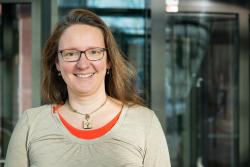Interview, 28. July 2025
"The global community must take action"
Negotiations on the UN Plastics Convention start on 5 August
Since March 2022, the global community has been negotiating a global plastics treaty within the framework of the United Nations Environment Programme (UNEP) – but no agreement has been reached so far. From 5 to 14 August, the next round of negotiations in Geneva (Intergovernmental Negotiating Committee (INC) 5.2) will make another attempt to reach a legally binding agreement aimed at ending global plastic pollution. Plastic pollution harms not only the environment and human health but also the climate. Environmental chemist Prof. Dr Annika Jahnke and ecotoxicologist Dr Dana Kühnel from the Helmholtz Centre for Environmental Research (UFZ) are advocating cooperation between the scientific, regulatory, industrial, and civil society sectors in order to achieve far-reaching improvements in pollution levels as quickly as possible. Within the INC 5.2 negotiations, they will support the "Scientists’ Coalition for an Effective Plastics Treaty" and the German delegation.
What are the UN negotiations on a global plastics treaty about?
Dana Kühnel: Through the Plastics Treaty, the UN aims to establish an internationally international legally binding framework to ensure that as many countries as possible to adopt standardised approaches to managing plastic. These include reducing plastic use and emissions, minimising harmful chemicals in plastics, and improving recycling methods in order to support a circular plastic economy. The agreement is intended to stand alongside the Paris Climate Agreement and the UN Convention on Biological Diversity.
Why is such an agreement needed?
Annika Jahnke: The production, use, and disposal of plastic are globally interlinked. The raw plastics come from countries such as India and Saudi Arabia; the plastic products are produced mainly in the Global North before being used worldwide. When there are no effective waste collection systems, plastic enters the environment and spreads in all directions. Like many other environmental pollutants, plastic does not stop at national borders and therefore causes transboundary problems. Plastic waste of all shapes and sizes can be found in virtually every corner of the Earth – from alpine glaciers and open oceans to the deep sea and remote island states . As a result, action must be coordinated between the countries. Furthermore, plastic is extremely persistent in the environment. If it sinks to the seabed, it degrades only very slowly because sunlight does not reach these depths and the temperatures remain consistently low.
Kühnel: We also know from forecasts that plastic production is expected to double by 2050. This increase creates an urgent need to better manage plastic production, use, and waste on a global scale.
What makes plastics so dangerous?
Kühnel: On one hand, there is a wide range of materials because the industry produces plastics using various raw materials, including polymers as the base material and functional additives such as plasticisers and UV stabilisers. Once in the environment, plastic weathers and breaks down, forming micro- and nanoplastic particles. Plastic waste harms marine wildlife that become entangled in larger items such as fishing nets. They also mistake both larger plastic fragments and micro- or nano-sized particles for food. The smallest ones can then enter the bloodstream through the intestinal wall. It is also certain that humans ingest plastic particles. It remains to date unclear how many of these particles remain in the body or are excreted. On the other hand, plastic-associated chemicals are released over time. More than 16,000 chemicals are used in plastics. Around one quarter of these are hazardous. They can negatively impact the environment and, amongst others, interfere with hormone function in humans.
So far, it has not been possible to agree on a global plastics agreement. What are the main areas of contention?
Kühnel: For example, one group of countries includes mainly oil-producing nations. It is in favour of managing plastic waste and increasing recycling – with the aim of reducing the amount of plastic entering the environment. However, it has little interest in curbing the production of plastics.
Jahnke: The “High Ambition Coalition to end plastic pollution”, which is led by Norway and Rwanda and includes the EU and Pacific small island developing states, takes a different position. It advocates further measures such as regulating the primary production of plastic, reducing single-use plastic products, controlling the use of plastic-associated chemicals, or replacing them with other less harmful substances. This group focuses on not only the waste problem but also the entire life cycle of plastic.
Overall, the negotiating parties so far remain far apart, particularly regarding the goals the international community should adopt and the extent to which individual states should be mandated to implement measures. It also remains unclear how the costs of removing plastic from the environment should be divided. The Global South and Indigenous peoples use less plastic than average but are disproportionately affected by its consequences. They are therefore calling for financial support from the main contributors to plastic pollution. Although many countries are fundamentally willing to contribute, they first want assurance that their ambitious demands are considered. At the conference in Busan (South Korea) in December 2024, there was little progress – and not only on this issue.
How can progress on this issue be revived?
Jahnke: Given the complexity of the problem and the need for multiple solutions, one approach would be to strengthen cross-sectoral collaboration. As outlined in our recent scientific publication, we believe it is urgent for scientists, policy-makers, regulators, the plastics industry, and civil society to engage in dialogue. This is the only way we can counteract plastic pollution quickly and comprehensively.
When would you say the conference was a success?
Jahnke: Ideally, a binding agreement would be reached on targets for plastic-associated chemicals, primary plastic production, and bans on plastic products of concern, which could then be negotiated at a Conference of the Parties (COP). These goals could be embedded in the agreement and later negotiated in detail by independent groups. In addition, regular updates based on the latest state of scientific knowledge are necessary.
Kühnel: Taking into account the entire life cycle of plastics – from resource extraction and production to disposal and recycling – would be an ideal outcome of the agreement. Regulation should address not only plastic waste but also plastic production – because that’s where the problems start. The global community must take action. The longer the delay, the more severe the problems become.
Publication:
Jahnke, A. et al.: Perspective article: Multisectoral considerations to enable a circular economy for plastics; Journal of Hazardous Materials, 21 July 2025; https://doi.org/10.1016/j.jhazmat.2025.139326
Further information:
- UFZ Press release, July 2025: "Underestimated sources of marine pollution"
- UFZ Press release, February 2025 "Nanoplastics at lofty heights"
- UFZ Press release, November 2024: "Environmental Impacts of Plastics: Moving beyond the perspective on waste"
- UFZ Press release, March 2024: "There are large accumulations of plastics in the ocean, even outside so-called garbage patch"
- Project website P-LEACH
- "High Ambition Coalition to end plastic pollution"
- "Scientists’ Coalition for an Effective Plastics Treaty"
Further information
Prof Dr Annika Jahnke
Head of UFZ Department Exposure Science
annika.jahnke@ufz.de
Dr Dana Kühnel
UFZ Department Ecotoxicology
dana.kuehnel@ufz.de
UFZ press office
Susanne Hufe
Phone: +49 341 6025-1630
presse@ufz.de
In the Helmholtz Centre for Environmental Research (UFZ), scientists conduct research into the causes and consequences of far-reaching environmental changes. Their areas of study cover water resources, ecosystems of the future, environmental technologies and biotechnologies, the effects of chemicals in the environment, modelling and social-scientific issues. The UFZ employs more than 1,100 staff at its sites in Leipzig, Halle and Magdeburg. It is funded by the Federal Government, Saxony and Saxony-Anhalt.
www.ufz.deThe Helmholtz Association contributes to solving major challenges facing society, science and the economy with top scientific achievements in six research fields: Energy; Earth and Environment; Health; Key Technologies; Matter; and Aeronautics, Space and Transport. With some 39,000 employees in 19 research centres, the Helmholtz Association is Germany’s largest scientific organisation.
www.helmholtz.de

